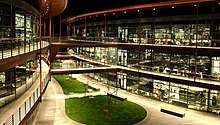James H. Clark Center
The James H. Clark Center (also abbreviated to the Clark Center) at Stanford University, California, United States, is a building, completed in 2003, that houses interdisciplinary research in the biological sciences.

History
The former Stanford computer scientist and entrepreneur James H. Clark donated $90 million of the total cost of $150 million to fund construction of the James H. Clark Center for interdisciplinary biomedical research.[1] Construction started in 2001 and was completed in the summer of 2003, as part of the Stanford University Bio-X program.[2] In September 2001, Clark rescinded $60 million of his initial 1999 pledge of $150 million to Stanford University for Bio-X, citing anger over President George W. Bush's restrictions on stem cell research.[3]
The building was designed by Foster and Partners[4] in collaboration with MBT Architecture, and was funded by donations from James H. Clark and Atlantic Philanthropies.[5]
Tenants
The Clark Center is home to Stanford's Bio-X Program, which seeks to encourage researchers in the biological sciences to interact with researchers in other fields.
See also
- Dry Lab
References
- Baker, Mitzi (October 29, 2003). "Clark Center, 'nucleus for a range of new research' opens". news.stanford.edu. Stanford Report. Retrieved December 17, 2017.
The building's other major donor, previously anonymous, was The Atlantic Philanthropies, which contributed $60 million.
- "Clark Center". biox.stanford.edu. Stanford University. Retrieved December 17, 2017.
- Ornstein, Charles (September 1, 2001). "Donor Stops Big Payment to Stanford". LA Times. Retrieved December 29, 2010.
- "James H. Clark Center, Stanford University". Foster + Partners. 2003. Retrieved April 24, 2020.
- "Clark Center". Bio-X. Stanford University.
External links
| Wikimedia Commons has media related to James H. Clark Center. |